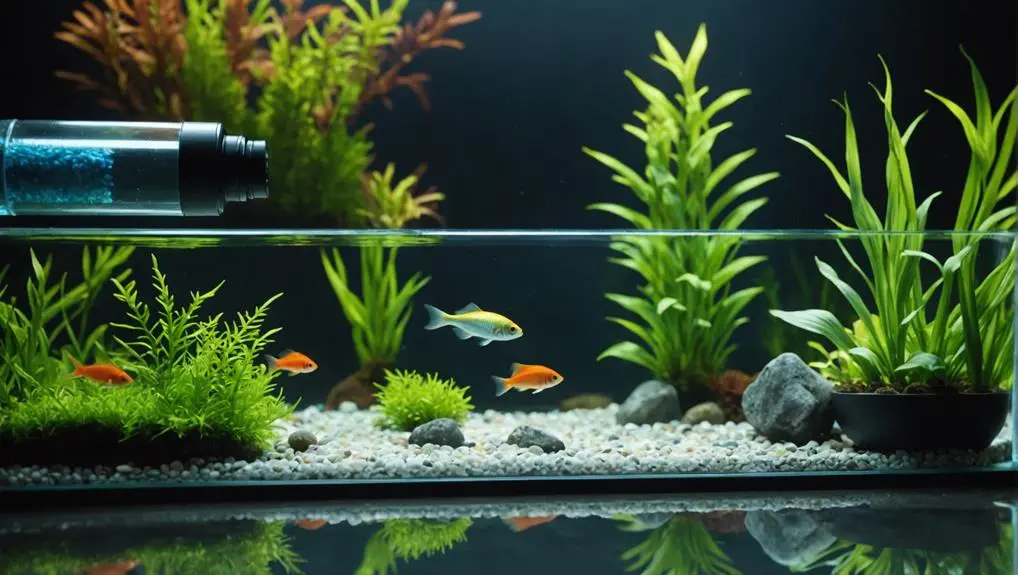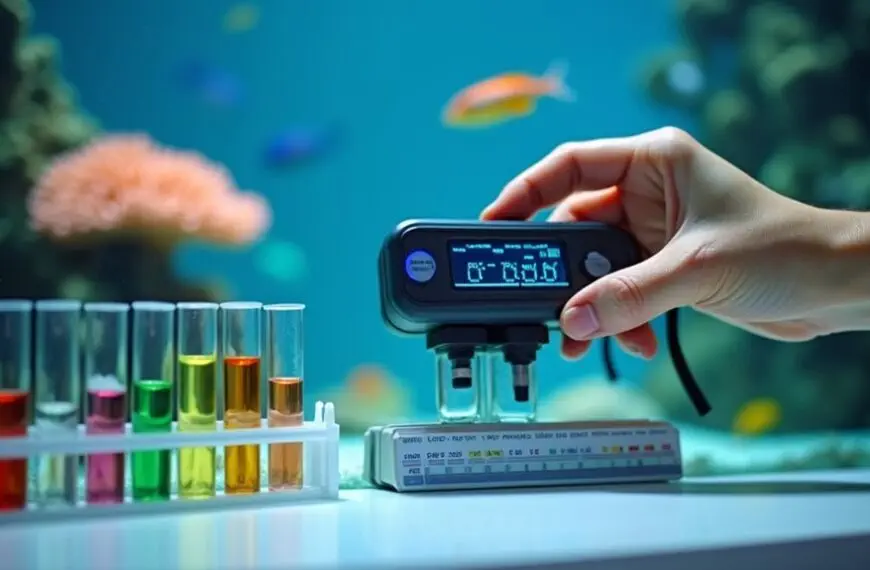To test your fish tank water quality, start by checking key parameters like ammonia, nitrite, nitrate, pH, and phosphate. You'll want ammonia and nitrite at 0 ppm—consider them the no-no's of the fish world! Use test strips for quick checks or a liquid kit for more accuracy. Collect your sample in a clean container, mix it with reagents if needed, and compare results to a color chart. Aim to test new tanks daily and established tanks every few weeks. Stay sharp about changes in your environment, too, as they can sneak up on your fish. There's a lot more to fish care, so stick around!
Contents
- 1 Importance of Water Testing
- 2 Key Water Parameters to Monitor
- 3 Testing Methods and Tools
- 4 Step-by-Step Testing Process
- 5 Recommended Testing Frequency
- 6 Managing Ph and Alkalinity
- 7 Addressing Ammonia and Nitrite Levels
- 8 Nitrate and Phosphate Management
- 9 Impact of Environmental Changes
- 10 Engaging With the Aquarium Community
- 11 Frequently Asked Questions
- 12 Final Thoughts
Importance of Water Testing
Water quality is vital for your fish's health, and regular testing can make all the difference. You might think your aquarium looks crystal clear, but harmful substances like ammonia and nitrite can be lurking below the surface.
These sneaky toxins can wreak havoc on your fish, leading to serious health issues or even sudden loss. That's why keeping an eye on water parameters is essential for a healthy aquarium.
You'll want to focus on a few key elements: ammonia should always be at 0 ppm, nitrite should also be at 0 ppm, and nitrate levels ideally stay below 40 ppm.
Plus, pH levels should hover between 6.5 and 7.5 for your freshwater fish to thrive. It sounds like a lot, right? But don't worry! Many local fish stores offer free or monthly water testing services, making it easy to keep track.
Routine testing allows you to catch potential problems early, so you can take action before things go south.
Key Water Parameters to Monitor
Maintaining a healthy aquarium requires you to keep a close eye on several key water parameters. First up, ammonia levels should always be at a big fat 0 ppm. Even tiny traces can stress your fish or, worse, lead to their demise.
Next, nitrite levels also need to hang out at 0 ppm. This toxic compound can sneak in if those beneficial bacteria aren't doing their job.
Now, let's talk nitrate levels. Keeping them below 50 ppm is essential for fish health, but aiming for under 20 ppm is even better. Your fish will thank you for it!
You also need to monitor pH levels to stay within the sweet spot of 6.5 to 8.0, especially for most freshwater species. Sudden changes can really throw a wrench in their day.
Lastly, if you're battling algae growth, don't forget phosphate levels. Ideally, they should be between 0.5 to 2 ppm for low-light setups.
Regular water testing is crucial for maintaining water quality, ensuring your aquatic pals thrive without any drama. Who knew fishkeeping would come with such a chemistry lesson? But trust me, it's worth it!
Testing Methods and Tools
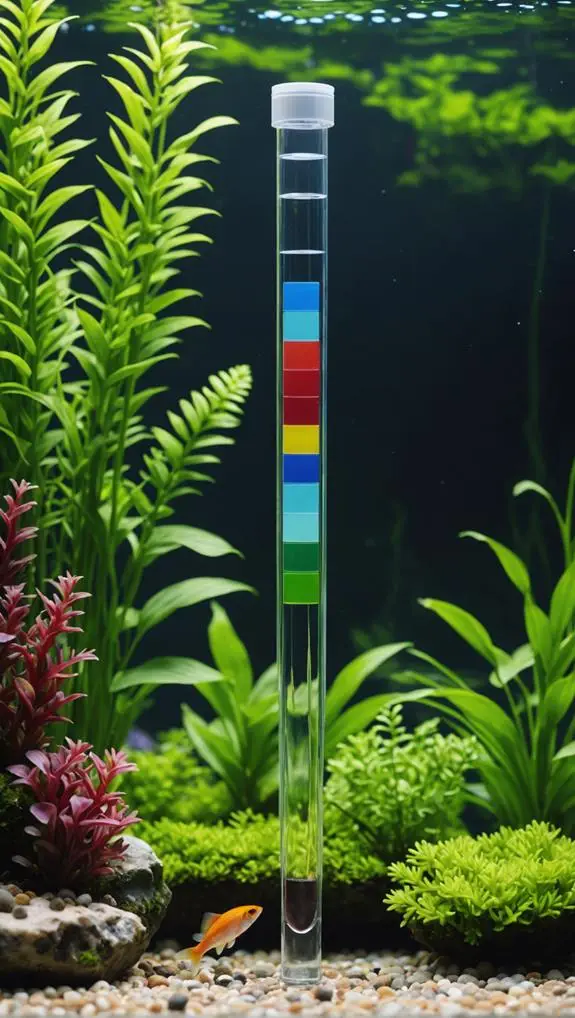
When it comes to testing your fish tank water quality, having the right tools can make all the difference. You want to ensure your aquatic friends are thriving, and the right testing methods will help you do just that.
Here are some reliable testing kits you might consider:
1. Test Strips: These are quick and user-friendly, giving you a basic idea of your water parameters. Just dip and read!
However, they may lack the accuracy of other methods.
2. Liquid Test Kits: Need precise measurements? These kits mix water samples with reagents to measure parameters like ammonia, nitrite, and nitrate accurately.
3. Digital Meters: For instant readings, digital meters are a great choice. They provide precise measurements for pH and temperature, making it easy to stay on top of your tank's needs.
4. Comprehensive Testing Kits: If you want convenience, these kits cover multiple water parameters, ensuring you don't overlook any essential tests while saving you money.
Selecting the right tools will empower you to maintain a healthy environment for your fish.
After all, a happy tank leads to happy fish!
Step-by-Step Testing Process
Now that you've selected the right testing tools for your fish tank, it's time to put them to use. First, grab a clean container to collect your water sample—this helps avoid any nasty contamination. Make sure to fill it to the recommended level in your test kit instructions; nobody wants a half-hearted test!
If you're using liquid test kits, add the required number of reagents to that sample. Mix it well to kickstart the chemical reaction needed for accurate results. For test strips, just dip one into the water for the instructed time, then pull it out and let it develop.
After waiting a bit, compare the color on your strip or in the vial to the provided color chart to check your water's pH, ammonia, nitrite, and other vital parameters. Remember, this isn't just science—it's your fish's home!
Don't forget to record your test results, so you can track changes and maintain optimal water quality. Keeping a close eye on these numbers helps you create a thriving environment for your aquatic friends, and that's what it's all about!
Recommended Testing Frequency

When you've got a new tank, daily testing for ammonia, nitrite, and nitrate is a must—it's like keeping an eye on a newborn!
For established tanks, every 2-4 weeks should do the trick, but keep an eye out for any fish drama or health issues that might call for more frequent checks.
Plus, if you've got an outdoor pond, don't forget to check in with the water a few times a year, especially when the seasons change; after all, even fish can be a bit moody when the weather shifts!
New Tank Requirements
Setting up a new fish tank can be exciting, but it also comes with important responsibilities, especially regarding water quality testing. You want to ensure your aquatic friends thrive, and that starts with keeping a close eye on water parameters during the crucial cycling phase.
Here are some essential testing guidelines:
- Test ammonia levels daily to monitor the development of beneficial bacteria. This will help you avoid a toxic environment for your fish.
- Check nitrite and nitrate levels daily, too; they can fluctuate as your tank cycles.
- Test pH levels at least once a week. Stable pH is vital for fish acclimatization—nobody likes a roller coaster!
- Conduct weekly water changes of 10-20% if ammonia or nitrite levels exceed safe limits. This keeps water quality in check.
Routine Monitoring Intervals
Monitoring water quality doesn't stop once your tank is established. In fact, routine testing is crucial for maintaining a healthy environment for your fish.
For established tanks, aim to test your water every 2-4 weeks. Keep an eye on your nitrate levels, as these can sneak up on you and impact fish health. If you notice any unusual behavior or injuries in your fish, increase your testing frequency. It's better to catch potential issues early, right?
Don't forget about outdoor ponds! Testing them 3-4 times a year helps you track seasonal changes that could affect water quality.
Additionally, whenever you make significant environmental changes—like adding new fish or doing a water change—it's a smart move to test again. You want to ensure everything stays stable for your aquatic friends.
Environmental Influence Considerations
Environmental factors can significantly impact your fish tank's water quality, making it essential to adjust your testing frequency accordingly. Here are some key moments when you should step up your testing game:
- Seasonal Changes: Test your water quality 3-4 times a year to see how changing seasons affect your fish health and water parameters.
- Environmental Events: After heavy rains or storms, increase your testing frequency. Runoff can alter the chemical composition, and you want to keep your aquatic friends safe.
- New Additions: Whenever you introduce new fish or plants, check the water quality. You want to ensure they don't throw your tank's balance out of whack.
- Algae Blooms: If you notice an unexpected surge in sunlight or nutrients, it's time for a quick water test. High nitrates and phosphates can lead to unsightly algae blooms that your fish won't appreciate.
Managing Ph and Alkalinity
Managing pH and alkalinity in your fish tank is like keeping a delicate balance on a seesaw—too much tilt and things can go south quickly.
You'll want to measure pH regularly to ensure it stays between 6.5 and 7.5, while also keeping an eye on alkalinity to prevent those pesky sudden changes.
Don't worry, with the right testing kits and a little patience, you can easily adjust the levels and keep your aquatic friends happy and healthy!
Ph Measurement Techniques
Maintaining optimal pH levels in your fish tank is essential for a thriving aquatic environment.
Most tropical fish prefer a pH range of 6.5 to 7.5, so it's crucial to monitor this regularly.
Here are some effective pH measurement techniques you can use:
- pH Test Strips: These provide a quick assessment but might lack precision.
- Liquid Test Kits: For more accurate readings, mix your water sample with reagents. It's like science class, but with fish!
- Check Source Water: Regularly test both your source and aquarium water, as fluctuations can happen from biological waste or even new fish introductions.
- Alkalinity Tests: Conduct these monthly to keep a buffer against rapid pH changes, ensuring stable water conditions for your fish.
Adjusting Alkalinity Levels
Adjusting alkalinity levels in your fish tank is vital for creating a stable environment for your aquatic life. Alkalinity, measured as carbonate hardness (KH), acts as a buffer to stabilize pH levels. Ideally, you should keep it between 3-10 dKH for freshwater tanks.
Regular testing is crucial—fluctuations can stress your fish, especially during water changes or if you're using untreated tap water.
To increase alkalinity, you can add bicarbonate of soda (or baking soda) at a rate of 1 teaspoon per 5 gallons of water. This method raises KH without significantly altering pH.
If you need to lower alkalinity, consider performing partial water changes with softer water or using reverse osmosis water. Just remember, avoid sudden drastic changes; they can be harmful to fish.
Monitoring both pH and alkalinity is essential since they impact each other. Low alkalinity can lead to pH swings, which can be harmful to your fish and plants.
Addressing Ammonia and Nitrite Levels
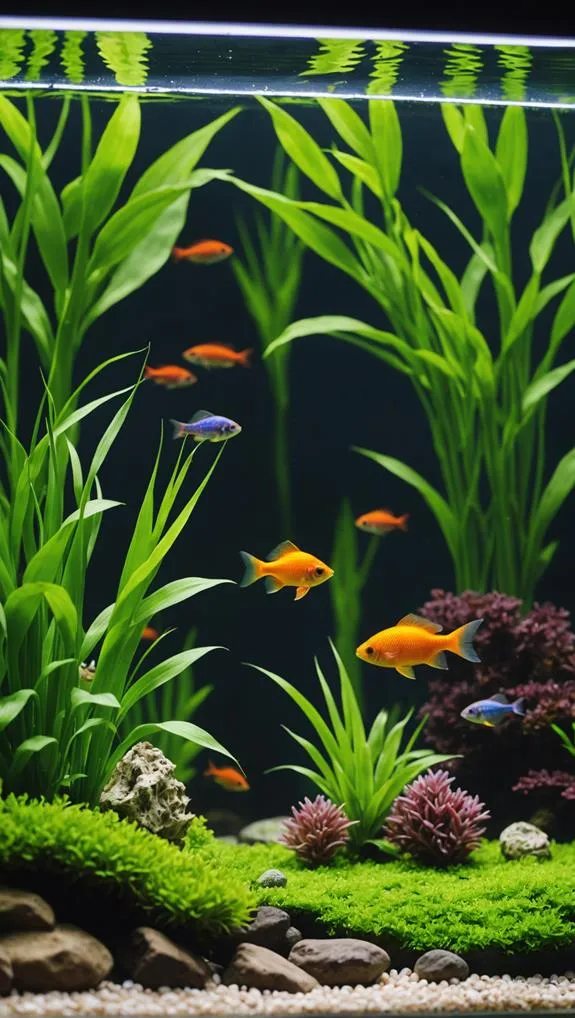
Monitoring ammonia and nitrite levels in your fish tank is critical for a healthy aquatic environment.
Keeping these levels at 0 ppm ensures your fish thrive without the risk of toxicity.
Even small amounts can lead to serious health issues or fatalities, so let's keep things safe for your finned friends!
Here are some essential steps to address ammonia and nitrite levels:
- Regular Testing: Use test kits designed to detect ammonia and nitrite. Daily testing during the initial cycling of your tank is a must.
- Watch for Changes: If you notice elevated ammonia or nitrite levels, don't panic! Take quick action to protect your fish.
- Perform Partial Water Changes: This simple step can help dilute harmful substances and improve water quality.
- Add Beneficial Bacteria: Introducing beneficial bacteria can speed up the cycling process, helping to break down toxins more efficiently.
Nitrate and Phosphate Management
When it comes to keeping your fish tank healthy, monitoring nitrate and phosphate levels is key.
You want to keep those nitrates below 40 ppm to avoid stressing your fish, and for phosphates, aim for the sweet spot between 0.5-2 ppm, unless you've got a high light setup.
Regular testing and a few smart strategies can help you manage these nutrients, so your underwater friends stay happy and your plants thrive—no one wants a surprise algae party in their tank!
Nitrate Level Monitoring
Maintaining optimal nitrate levels is crucial for your fish tank's health and overall ecosystem balance. Keeping nitrate levels below 40 ppm is key for fish health, while levels between 20-50 ppm can actually promote plant growth.
By monitoring these levels, you're helping both your aquatic friends and the lush greenery thrive.
Here are some effective steps to manage nitrate levels:
- Incorporate Live Plants: They absorb nitrates as nutrients, keeping your water quality high and your fish happy.
- Conduct Regular Water Changes: This dilutes nitrates and helps prevent harmful spikes that can stress your fish out.
- Test for Nitrates Frequently: Especially after feeding and water changes, this ensures a balanced environment that deters algae growth.
- Monitor Your Fish's Behavior: If they're acting unusually, it might be time to check those nitrate levels!
Phosphate Control Strategies
Effective phosphate control is essential for a healthy fish tank environment, as it directly impacts both fish and plant life. You want to keep phosphate levels in check to avoid excessive algae growth, which can be a real headache.
Aim for phosphate levels between 0.5-2 ppm for low light setups and 3 ppm or higher for high light setups. Regular water changes of about 10-20% each week can help dilute those pesky phosphates and maintain a balanced nutrient profile.
Incorporating live aquatic plants is a fantastic strategy too. Not only do they beautify your tank, but they also use phosphates and nitrates as nutrients, giving algae a run for their money.
Plus, they contribute to fish health by keeping the water cleaner. Consider using phosphate-absorbing media in your filter. It's like a secret weapon against algal blooms!
And don't forget to monitor both nitrate and phosphate levels regularly. This ensures your aquatic friends live in a thriving ecosystem.
With these strategies, you're not just caring for fish; you're creating a mini paradise!
Impact of Environmental Changes
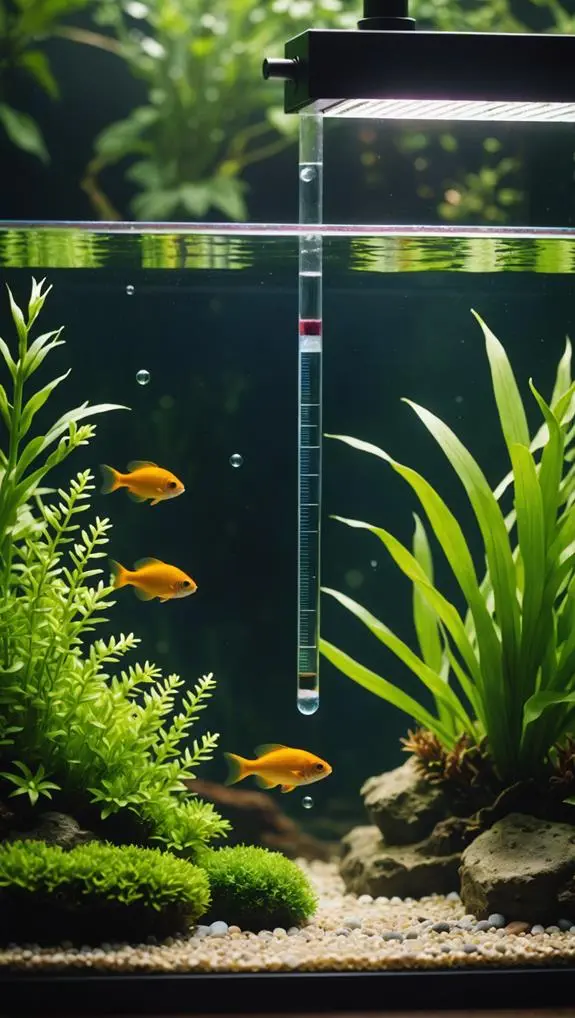
Environmental changes can dramatically affect the health of your fish, making it crucial to stay vigilant. Your aquatic buddies depend on you to keep their environment safe and stable. Here are some key factors to consider:
- Temperature Fluctuations: Keep an eye on water temperature. Ideal tropical species thrive between 75°F and 80°F. Sudden changes can stress your fish.
- Water Chemistry: Seasonal variations can alter water chemistry, especially during spring and summer. Test more frequently to catch rising ammonia levels and changes in pH.
- Algae Overgrowth: Increased sunlight exposure can lead to algae overgrowth. This not only looks unappealing but can harm fish too. Regularly test for phosphates to keep things in check.
- Water Changes: Evaporation can concentrate contaminants, so regular water changes are essential.
After heavy rainfall, test for ammonia, nitrite, and nitrate levels, as runoff can introduce pollutants.
Engaging With the Aquarium Community
There's a wealth of knowledge waiting for you in the aquarium community, making it easier than ever to enhance your fish-keeping experience. By engaging with this vibrant community, you'll discover invaluable insights into water quality management and effective water testing methodologies.
Whether you're a novice or a seasoned aquarist, sharing your water test results in online platforms, like Reddit's r/Aquariums or specialized Facebook groups, can lead to immediate feedback from experienced enthusiasts.
Local fish clubs are fantastic places to dive deeper. They often host events where you can exchange tips tailored to different fish species. Plus, you'll meet fellow hobbyists who share your passion!
Participating in community challenges, such as aquascaping contests, emphasizes water quality's importance, sparking meaningful conversations about how parameters affect plant and fish health.
Don't forget about aquarium blogs and newsletters! Regularly reading them keeps you informed about the latest trends and innovative methods for maintaining water quality.
Frequently Asked Questions
How to Test Water Quality for a Fish Tank?
To ensure fish health, use water testing kits regularly. Check pH levels, monitor for ammonia spikes and nitrate accumulation. Maintain your tank by testing frequently, keeping your aquatic ecosystems thriving and your fish happy.
What Are the Most Important Aquarium Water Tests?
When testing your aquarium water, focus on pH levels, ammonia concentration, nitrite presence, nitrate levels, hardness measurement, temperature checks, chloramine detection, and phosphate analysis to ensure a healthy environment for your aquatic friends.
What Are the Parameters for a Fish Tank Water Test?
You should check pH levels, ammonia levels, nitrite levels, and nitrate concentration. Additionally, monitor chlorine presence, hardness measurement, temperature stability, and oxygen saturation to create a healthy environment for your fish and plants.
What Is the Water Quality Monitoring for Aquariums?
Water quality monitoring ensures your aquarium health. You should test frequently, using measuring tools to check for common contaminants. Maintaining ideal conditions and understanding impact factors helps you implement preventative measures for thriving aquatic life.
Final Thoughts
So, there you have it! By keeping a close eye on your water quality, you're not just a fish parent; you're a true aquatic superhero! Remember, testing water isn't just a chore—it's your ticket to a thriving underwater world. When you engage with fellow fish enthusiasts, you'll find a treasure trove of tips and tricks, making your aquarium journey even more enjoyable. Dive in, stay curious, and watch your little finned friends flourish!

